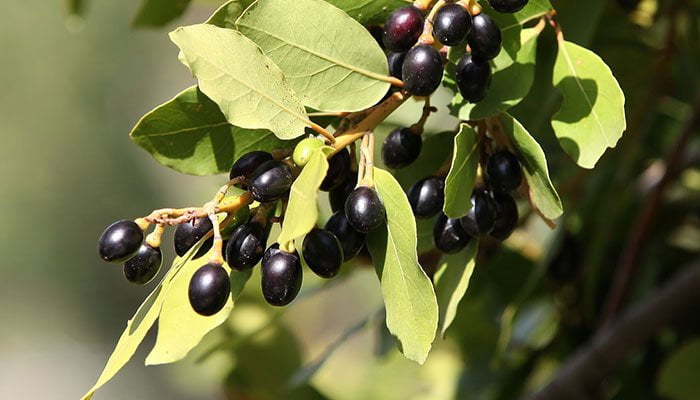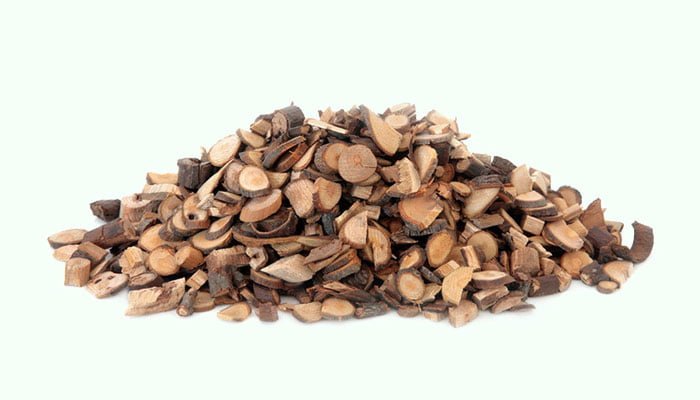What Is Gui Zhi
Gui Zhi commonly known as Ramulus Cinnamomi, Cinnamon Twig, or Cassia Twig is the twig of Cinnamomum cassia, which is an evergreen tree belonging to the Lauraceae family. It is a commonly used Chinese herbal medicine, which first appeared in <Shennong Ben Cao Jing> in the late Western Han Dynasty (around 100 BCE).
Cinnamomum cassia is also called Chinese cassia or Chinese cinnamon and is an economic plant. Its trunk can be made into furniture, and Its bark can be into spices.
This plant likes a warm and humid environment and is often planted in subtropical frost-free areas and tropical areas. It is a deep-rooted tree, which can grow well in slightly acidic or acidic soils with deep soil, loose texture, good drainage, and strong permeability. It is native to China, India, Laos, Vietnam, and Indonesia.

In spring and summer every year, people gather the twigs of Cinnamomum cassia, remove their leaves and impurities, dry them in the sun, cut them into slices, and make them into Chinese herbs.
Gui Zhi contains cinnamaldehyde, cinnamyl alcohol, methoxycinnamaldehyde, benzenepropanal, 3-hydroxy-benzaldehyde, 2-prepen-1-ol-3-phenylacetate, camphene, 1,8-Cineole-β-cymene, terpinen-4-ol, α-copane, β-elemene, Calamenene, cinnamic acid, 2-methoxycinnamic acid, E-o-hydroxycinnamic acid, 4-hydroxybenzoic acid, 2-methoxy benzoic acid, protocatechuic acid, coumarins, tannins, β-sitosterol, and potassium sulfate crystals.
In general, the reddish-brown or brown, young tender Gui Zhi with an aroma are preferred.
According to the Chinese Pharmacopoeia, the medicinal nature of Gui Zhi is relatively warm, with a pungent and sweet taste. It has a certain therapeutic effect on the pathological changes of the heart, lung, and bladder meridians.
In traditional Chinese medicine (TCM), Gui Zhi is often used to promote perspiration and relieve exterior symptoms, warm and dredge the meridians, treat fever caused by wind-cold, irregular menstruation, amenorrhea, dysmenorrhea, postpartum abdominal pain, cold pain of stomach and abdomen, phlegm-fluid retention disease, edema, palpitations, pediatric bronchial asthma, chronic hepatitis B, liver cirrhosis, cerebral infarction, angioneurotic headache, anorexia, endometriosis, cystic infertility, chronic pelvic inflammatory disease, menopausal syndrome, postoperative intestinal adhesions, prostatic hypertrophy, chilblains, Raynaud’s disease, sciatica, acute gout, allergic rhinitis, urticaria, chloasma, ventricular premature beats, and diabetic peripheral neuropathy.
There are about 200 kinds of Chinese medicine prescriptions containing it, such as Gui Zhi Tang, Gui Zhi Fu Ling Wan, Ma Huang Tang, and Jin Kui Shen Qi Wan.
Benefits
- Inhibiting influenza A virus and orphan virus.
- Anti-inflammation, inhibiting mouse ear swelling induced by xylene and increased permeability of abdominal capillaries.
- Raising the pain threshold and inhibiting the pain caused by the hot plate experiment and glacial acetic acid experiment in mice.
- Promoting the secretion of saliva and gastric juice, and relieving gastrointestinal spasms.
- Inhibiting platelet aggregation and preventing thrombosis.
- Expanding skin blood vessels, promoting blood circulation, and facilitating blood flow to the body surface.
- Promoting sweat gland secretion, relieving fever, headache, and body pain caused by wind-cold.
- Warming and dredging the meridians, relieving chest pain and heartache caused by the inactivity of thoracic yang.
- Dispelling cold, relieving cold pain of stomach and abdomen caused by deficiency-cold in middle energizer.
- Treating irregular menstruation, amenorrhea, dysmenorrhea, and postpartum abdominal pain caused by congealing cold with blood stasis.
- Dispelling wind and dispersing cold, relieving shoulder and arm pain caused by wind-cold-dampness.
- Inducing diuresis, treating dysuria, phlegm-fluid retention disease, and edema caused by chronic nephritis.
- Boosting heart yang, and treating palpitations caused by devitalization of heart yang.
- Inducing the apoptosis of PLC/PRF/5 human liver cancer cells, BGC-823 human gastric carcinoma cells, and MHCC97 cells, and inhibiting the growth of MCF-7 breast cancer cells.
- Studies have confirmed that its decoction can inhibit typhoid bacteria, Bacillus anthracis, pneumococcus, Vibrio cholerae, Shigella dysentery, Salmonella enteritidis, Proteus, E. coli, Bacillus subtilis, and Staphylococcus aureus glucose.
Combinations
- It can be used in combination with Bai Shao (White Peony Root), Gan Cao (Licorice Root), Sheng Jiang (Rhizoma Zingiberis Recens), Hong Zao (Fructus Jujubae), etc. to treat fever, sweating with headache, retching, and white tongue coating caused by wind-cold.
- It can be used in combination with Wu Zhu Yu (Evodiae Fructus), Dang Gui (Radix Angelicae Sinensis), Mu Dan Pi (Cortex Moutan), etc. to treat irregular menstruation, amenorrhea, dysmenorrhea, and postpartum abdominal pain caused by congealing cold with blood stasis.
- It can be used in combination with Fu Zi (Radix Aconiti Lateralis Preparata), Sheng Jiang (Rhizoma Zingiberis Recens), Hong Zao (Fructus Jujubae), Gan Cao (Licorice Root), etc. to dispel wind-cold, and relieve shoulder and arm pain caused by wind-cold-dampness.
- It can be used in combination with Fu Ling (Poria), Zhu Ling (Polyporus), Ze Xie (Rhizoma Alismatis), etc. to promote urination, treat edema and dysuria.
- It can be used in combination with Gan Cao (Licorice Root), Ren Shen (Radix et Rhizoma Ginseng), Mai Dong (Radix Ophiopogonis), etc. to treat palpitations caused by devitalization of heart yang.
Side Effects
- At present, there is no literature report that Gui Zhi has toxic effects, and there is no data showing that taking it at the prescribed dose can cause serious adverse reactions.
- Overdose of it may cause hectic cheek, night sweats, spontaneous sweating, dry mouth, thirst, dry stools, and other adverse effects.
Precautions and Warnings
- The dosage of Gui Zhi should be controlled at 3-9g.
- It can be made into decoctions, pills, powders, or medicinal liquors.
- It contains volatile oils and is not suitable for long-term decoction.
- People who are allergic to Gui Zhi should not take it.
- Patients with febrile diseases should not take it.
- Patients with hyperactivity of fire due to yin deficiency should not take it.
- Patients with hemorrhage due to blood-heat should not take it.
- Pregnant women or women with the excessive menstrual flow should not take it.
